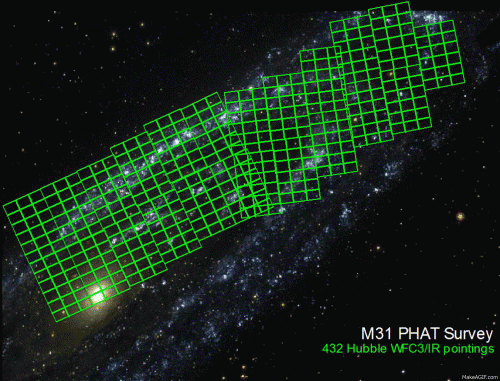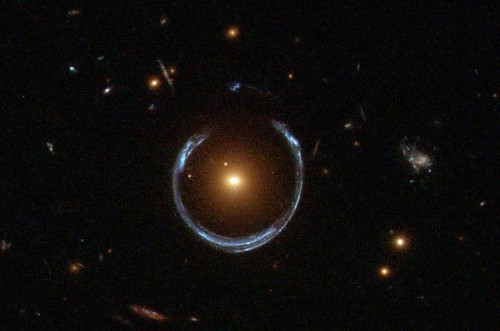While NASA is preparing for the launch in 2018 of the "James Webb" space telescope - the largest and most powerful space telescope planned to serve as the "successor" of the Hubble Space Telescope - NASA is already preparing for the space telescope that will come after it - WFIRST, which will observe the universe in the infrared range to investigate, among other things, the nature of dark energy and locate planets outside the solar system.

While NASA is preparing for the launch in 2018 of the "James Webb" space telescope - the largest and most powerful space telescope that is planned to serve as the "successor" of the Hubble Space Telescope - NASA is already preparing for the space telescope that will come after it. This month the agency announced the official start of the WFIRST space telescope project, which will be launched in the next decade and will observe the universe in the infrared range to study, among other things, the nature of dark energy and the location of planets outside the solar system.
WFIRST stands for Wide-Field Infrared Survey Telescope. The new telescope, whose launch is planned according to NASA in the "mid-twenties", will observe the universe in the infrared region of the electromagnetic spectrum. The telescope will include a wide-field camera that will provide it with a very wide field of view, 100 times that of the Hubble Space Telescope, but with the same quality and depth that Hubble has. The wide field of view will allow the telescope to observe large parts of the universe at once.

The idea to build the telescope was already raised in 2010, but then the proposal included a more limited telescope with a primary mirror with a diameter of 1.3 meters. Fortunately for the mission planners, in 2012 the National Reconnaissance Office, an American intelligence agency responsible for building and launching spy satellites, gave NASA, for free, two telescopic mirrors that were originally intended for spy satellites whose development was canceled. The diameter of these mirrors is 2.4 meters, just like the diameter of the main mirror of the Hubble Space Telescope, which allowed a significant increase in the capabilities of the telescope planned in the original proposal.
The announcement of the official launch of the project came after several years in which it was defined as research only. NASA intended to make it official at a later time, probably in 2017, but the final budget that the project received from Congress was much higher than the budget proposal that the Obama administration proposed for it in the 2016 NASA budget, so the project could be made official for its more advanced development . The total cost of the project is estimated at 2 to 2.3 billion dollars.
One of the telescope's goals is to investigate the nature and essence of dark energy, and it will do so using a number of methods. Dark energy, the nature of which is unclear, has been proposed as a force that explains the continued acceleration in the expansion of the universe - contrary to the expectations of researchers who speculated that the force of attraction between all the mass in the universe would slow down the expansion, observations show that on the contrary, the galaxies are moving away from each other at a speed that increases from moment to moment.
One of the methods WFIRST will employ to study dark energy is to precisely measure the acceleration in the expansion of the universe, by measuring the distance between thousands of Type Ia supernovae, a particular type of supernovae whose exact distance from Earth can be measured because their absolute luminosity is known (and not the one seen from the earth and depends on the distance).
The telescope will also help in the developing field of detecting extrasolar planets, some of which may be suitable for life. One method would be to directly photograph the planets, which would allow the spectrum of their light to be analyzed to identify the chemical composition of their atmospheres, if any. The light of planets is so weak that it is swallowed up by the light of their star. To identify them, the telescope includes an advanced chronograph, a device that hides the bright light of the stars and allows viewing the faint light of the planets that surround them.
The telescope will also be able to detect planets using a method known as "gravitational micro-clogging". Gravitational refraction is a phenomenon predicted by Einstein's theory of general relativity, according to which light rays bend around a massive body. When the mass that distorts the light rays is a star, planets orbiting it can affect the gravitational clouding it creates. From these changes, which are extremely easy, it is possible to locate and identify the planets of the star.

Another method by which the telescope will detect planets is the eclipse method, the one by which the Kepler space telescope has so far discovered more than a thousand planets, and the one by which the TESS (transiting Exoplanet Survey Satellite) space telescope, whose launch is scheduled to take place next year, will detect additional planets. With this method, when a planet passes by its star, it slightly dims the star's light, which makes it possible to discover its existence.
WFIRST's wide field of view will allow it to work together with other space observatories planned for future launches. For example, while the future James Webb space telescope will have a higher quality, it will have a very limited field of view. WFIRST will be able to widely survey the sky and find sites of scientific importance for the Webb Space Telescope, which will make a more detailed observation of them.
The telescope will be placed in orbit at the Lagrange point L2, a stable point in terms of the gravitational influence of the Earth and the Sun, which is 1.5 million km from the Earth in the direction away from the Sun, allowing it to avoid the Earth's shadow. The James Webb Space Telescope will also be located in this orbit.

5 תגובות
To be precise - according to Einstein it is the entire space-time that is warped around the source of gravity and not only the light rays are curved as Newton had already predicted who believed that gravity attracts the photons of light and diverts them from their path.
Itzik C
https://en.wikipedia.org/wiki/Imagery_intelligence#Satellite
It is interesting what the National Espionage Office intended to look at with a 2.4 meter mirror and it is interesting what one sees when it is aimed at the Earth even from geostationary orbit
A question to Elisef Kussman: how long have Shana's crew been in space and as of today, and what are their names?